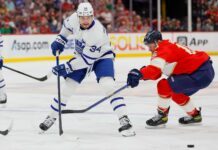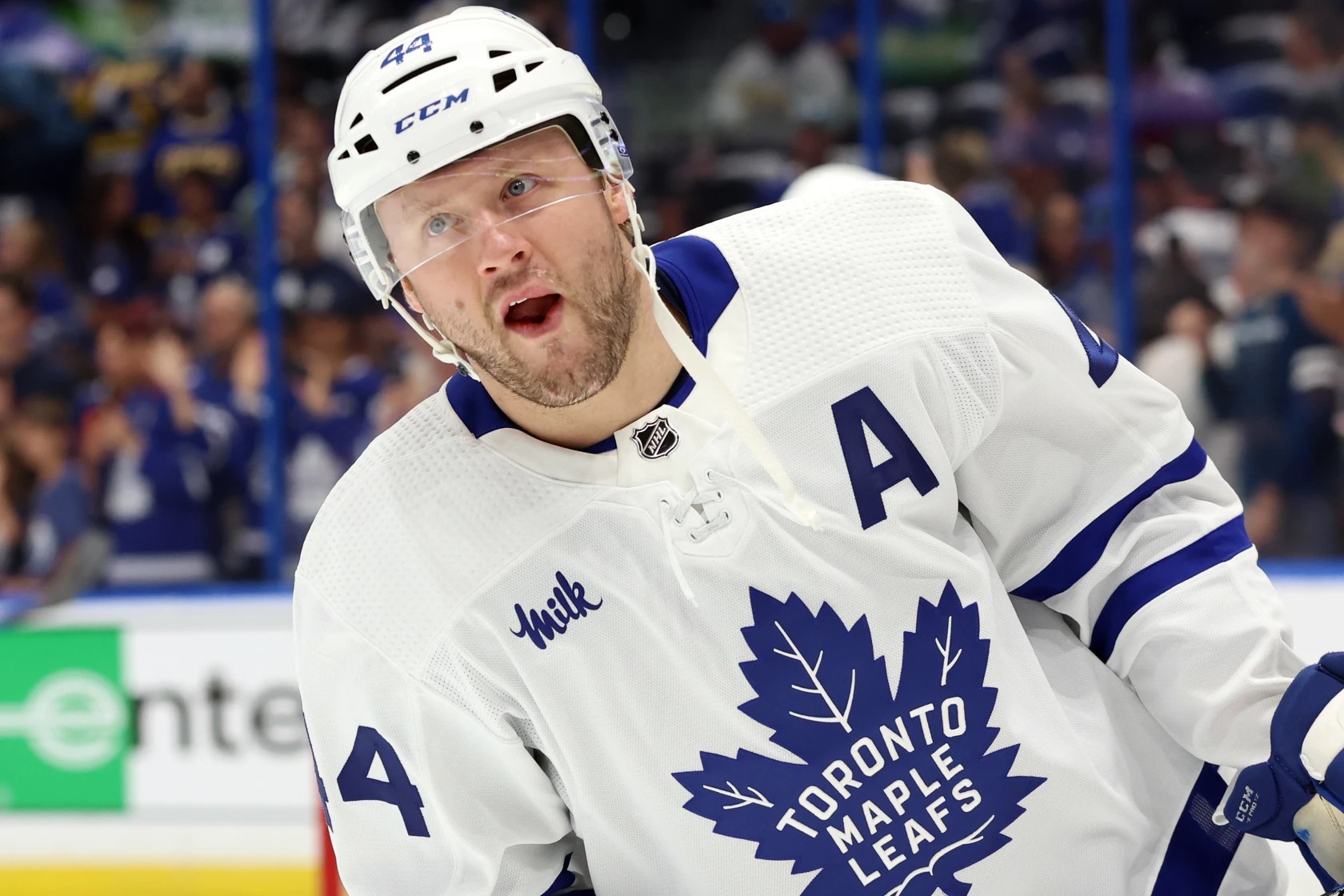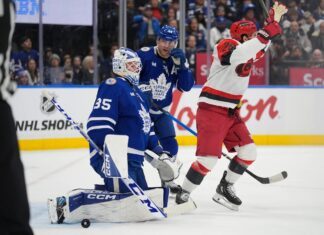The Offseason Evaluations series now turns to the defense position, the team’s most critical area of need this summer.
Catch up on my previous five pieces in the Offseason Evaluations series below:
- Offseason Evaluations, Part 1: Auston Matthews & William Nylander
- Offseason Evaluations, Part 2: Mitch Marner & John Tavares
- Offseason Evaluations, Part 3: David Kampf & Calle Jarnkrok
- Offseason Evaluations, Part 4: Bobby McMann & Matthew Knies
- Offseason Evaluations, Part 5: Pontus Holmberg & Ryan Reaves
Morgan Rielly
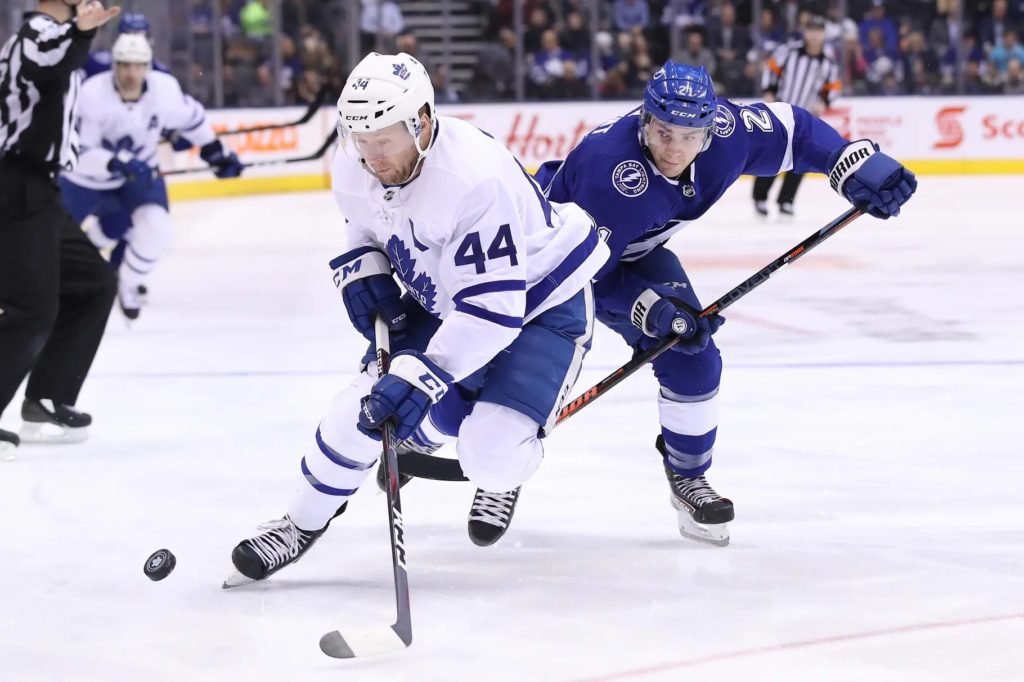
| Morgan Rielly | |
|---|---|
| 2023-24 Production | 7 goals and 58 points in 72 games (23:44 per game) |
| 5v5 Results | 50.46 CF% | 49.05 xGF% | 77 goals for, 66 goals against |
| Contract Status | Six years remaining at $7.5 million AAV (NMC) |
The 2023-24 campaign was a tale of two seasons for Morgan Rielly. He started the schedule paired with a swiftly declining TJ Brodie and on the second power-play unit as the Leafs tried out John Klingberg on the top unit. That Klingberg experiment didn’t last particularly long (just 14 games, to be exact), and Rielly was back on the top unit by November. Even while he was on the second unit, Rielly was productive, scoring seven points in his first nine games in October. He followed it up with nine in 12 in November, 11 in 13 in December, and 13 in 13 in January.
Overall, Rielly posted 40 points in 47 games (.85 points per game) before the All-Star break, including seven goals, while playing 24:19 per night and launching 123 shots on net (2.6 shots per game). It seems like ages ago, but Rielly was very good on a defense that offered him little support for the first half or so of the season. He was playing alongside a partner who saw his game fall off steeply (on his off-side, no less) and a supporting cast that basically only consisted of Jake McCabe for the first half of the season. Simon Benoit took time to find his footing, William Lagesson was a regular, John Klingberg played nearly 20 percent of the season (and struggled), and Timothy Liljegren once again got hurt. Rielly was a source of production and stability through all of the turbulence, logging massive minutes in the process.
After the All-Star break, things quickly fell apart for Rielly. He initially picked up right where he left off with three points in three games before the Ottawa game happened and Rielly was suspended for his cross-check on Ridly Greig. I don’t want to rehash the incident, but I will say that Rielly rightfully responded; he just approached it the wrong way (fight him/jump him, but he can’t cross-check him high in the face, or a suspension is inevitable). It was a turning point for the team as the Leafs rallied around the suspension and went on a run that cemented a playoff berth after largely lollygagging through the earlier parts of the season. Rielly has consistently responded when he has needed to answer the bell. He’s the only Leafs core player we can confidently say that about, which is worthy of recognition.
The Leafs went undefeated in Rielly’s absence, and Rielly noted that he didn’t want to mess up the team’s mojo when he returned. It seemed to impact his game as he tried to ease himself back in. Rielly tallied 15 points in 22 games (.68 points per game, a notable drop) after the suspension, and he didn’t score a goal for the rest of the season or the playoffs. His ice time also dropped nearly two full minutes (22:21 in those 22 games).
At the same time, TJ Brodie showed well on the left side in his absence and remained there, so Rielly returned to the lineup and played with William Lagesson. By the end of February, the Leafs acquired Ilya Lyubushkin and reunited him with Rielly. The pairing posted reasonable results, out-shooting and out-shot-attempting opponents at five-on-five, although they were outscored 8-7 overall in 160 minutes together.
In the playoffs, the pair continued outshooting the opposition and outscored Boston 4-1 at five-on-five. But the power play fell off a cliff, in which Rielly plays a critical role, and he recorded zero goals and three assists in seven playoff games. He scored at least a goal in the previous five playoffs, including four goals in the 2023 postseason. It was a disappointing performance by a player who has been a playoff gamer for the Leafs year in and year out.
Rielly finished 11th among NHL defensemen in scoring this season and logged top-pairing minutes (23:44). He’s clearly a good player even if he’s not a number-one stud defenseman (in fairness, he isn’t paid even close to one). This was Rielly’s 11th season with the Leafs, and he’s 11th all-time in games played for the franchise. If he plays a full season next season, he will pass Darryl Sittler for ninth all-time in Leafs history. Fans are more than aware of his strengths and weaknesses by this point.
Ilya Lyubushkin is an NHL defenseman, but no other playoff team came close to pairing their top defenseman with a player of Lyubushkin’s calibre other than maybe the Washington Capitals, who were a playoff team by definition only and a completely unserious team this year (and possibly moving forward after acquiring Pierre-Luc Dubois). Over the years, whenever Rielly’s partners are mentioned, there is often a strange response as if this is a normal expectation – as if other teams ask their elite defensemen to do something similar. That’s completely false.
Cale Makar doesn’t play with a third-pairing defenseman; he plays with Devon Toews, who has a strong chance to make Team Canada. The Leafs acquired Ilya Lyubushkin for two depth picks (because of salary retention) and paired him with their minute leader. The Avalanche acquired Sean Walker for a first-round pick and placed him on their third pairing.
In Dallas, Miro Heiskanen played with Thomas Harley, who had an excellent 2023-24 season. Aaron Ekblad and Gustav Forsling are paired together in Florida. Boston tried pairing Charlie McAvoy and Hampus Lindholm together as much as possible. This season, Tampa paired Victor Hedman with either Darren Raddysh or Nick Perbix and were run over by the Panthers. The Lightning promptly reacquired Ryan McDonaugh to add a viable top-four defenseman to their blue line.
If we go down the list of contenders and their top-pairing defensemen, practically none of them are treated this way. This is the second straight year the Leafs have acquired a third-pairing defenseman and attached him to Rielly for the playoffs. That’s not to say Rielly is perfect or without holes in his game, but the Leafs aren’t setting him up – or their overall team – for success. They need to acquire a proper right-handed top-four defenseman and give Rielly a real chance to thrive. When he was paired with Brodie in Brodie’s prime seasons, the pairing posted excellent results.
Ultimately, this should really be the Leafs’ top priority of the offseason: adding a quality, top-four defenseman – preferably a right-handed one – to play with Rielly, allowing the team to ice a strong top pairing for the first time in many years. The domino effect throughout the lineup would be significant. A proper top pairing makes the top forward line better (MacKinnon and McDavid both benefit from one). It also makes their fourth line better when the coaching staff can sneak them out with the top defense pairing, who can make sure things run smoothly.
It’s hard to overstate how much of a difference a proper partner would make for Rielly and the Leafs at large. It should be priority number one this offseason.
Conor Timmins
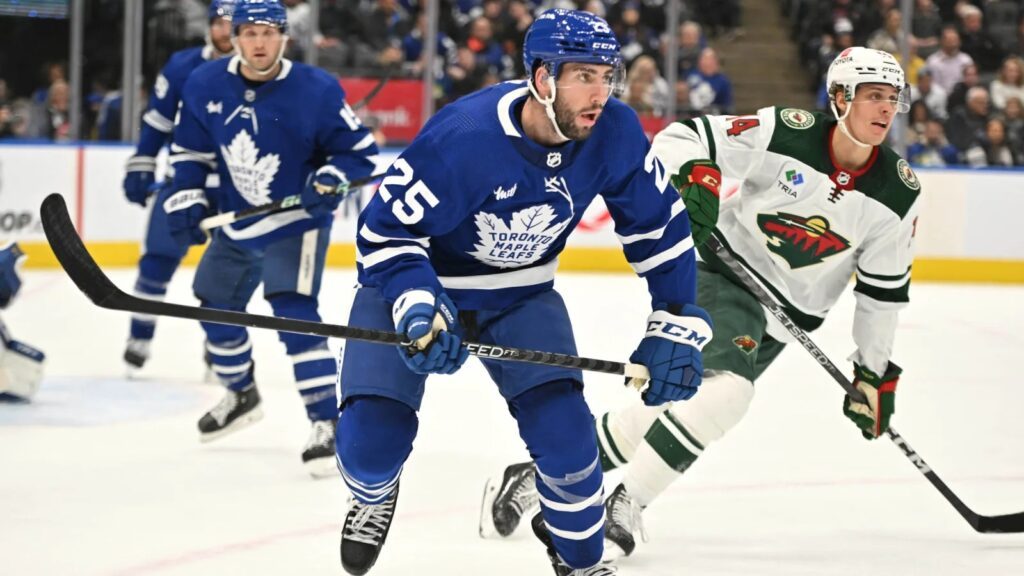
| Conor Timmins | |
|---|---|
| 2023-24 Production | 1 goal and 10 points in 25 games (16:01 per game) |
| 5v5 Results | 56.44 CF% | 60.23 xGF% | 21 goals for, 13 goals against |
| Contract Status | One year remaining at $1.1 million |
Timmins played 25 games for the Leafs for the second straight season, was productive in those appearances, and posted good underlying numbers in a sheltered role. However, he couldn’t stay healthy enough to seriously challenge for a full-time lineup spot.
Timmins started the preseason on fire with six points in two games, which led all NHL defensemen in exhibition scoring. In the third game, though, he sustained a knee injury and didn’t appear in his first regular-season NHL game until November 24. Understandably, he got off to a slow start with one assist and one shot on net in four games through the rest of November while averaging 14:15 per night. But he stayed in the lineup, and in December, he actually got on a bit of a roll with five points in nine games while averaging 17:08 per game.
One can envision Timmins playing this type of role: reasonable third-pairing minutes, chipping in offense with sheltered usage. He scored his only goal of the season in December against the Rangers on a point shot that he sifted through traffic. Timmins is one of the only Leafs defensemen with the skill to contribute offensively in that manner.
However, the last game of that December run for Timmins was a disaster as the Leafs were crushed by the Sabres, and Timmins had more than a few ugly moments while posting a dash-four on the night. It earned him a healthy scratch in favour of William Lagesson, and Timmins didn’t get back into the lineup for nearly three and a half weeks until the Leafs played a back-to-back. He appeared in three games afterward, played fine, and was then out of the lineup before it was again revealed that he was unavailable, this time due to mononucleosis.
The Rielly suspension overlapping Timmins’ absence was particularly bad timing, as it would have offered Timmins a locked-in spot for the five games with real power-play opportunities. With the opportunity to make a statement and claim a roster spot at a time when the Leafs were often dressing six left-handed defensemen, he wasn’t healthy enough to play.
Availability – or lack thereof – is really the story of Timmins’ career to this point. He missed two months with mono and didn’t play again until late March. When he returned, it was simply about reps for a player low on game action. He had no chance whatsoever to crack the playoff lineup.
For what it’s worth, Timmins did record four points in those nine games to end the season, playing largely with Simon Benoit, as the pairing won their minutes across the board (shot attempts, chances, and actual goals – 6-5). They provided some size and a bit of a yin-and-yang complement on the third pairing.
At $1.1 million, the Leafs can fully bury Timmins’ contract without any penalty against the cap. After his contract expires, he’ll also still be a restricted free agent, so if he did finally stay healthy and turn in a good season, the Leafs would still own his rights.
Timmins is cheap, right-handed, and clearly talented. He can move well, owns a great shot, and can rip high-end breakout passes. On the flip side, he hasn’t played more than 40 games in a single season since the 2019-20 campaign. The lack of playing time has clearly hurt his development as he lacks details defensively, especially evident when dealing with aggressive forechecks. Working through those kinks takes time and repetition, and Timmins hasn’t played enough to do it. He simply hasn’t been available.
Ultimately, it’s a cheap enough contract, and Timmins has enough skill and upside to justify keeping around. Of the Leafs’ four defensemen under contract, he’s the only right-handed one. Are the Leafs really going to be able to acquire three right-handed defensemen and four defensemen overall? They shouldn’t be running a league-minimum roster and should enter the season with seven defensemen on the NHL roster. Short of some team offering a notable draft pick for Timmins, it makes the most sense to bring him to camp to compete for one of those spots as a right-handed defenseman with some skill to produce offensively.
Next up in the Offseason Evaluations series: Jake McCabe & Simon Benoit

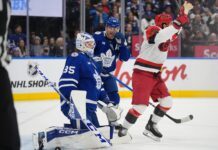
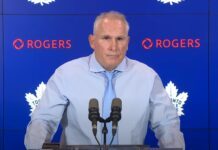
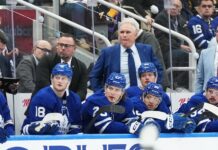

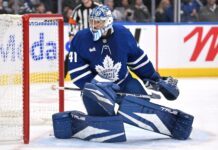



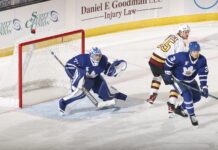
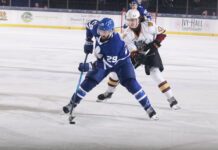

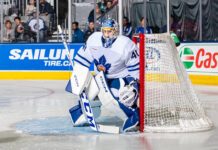

![John Gruden after the Leafs prospects’ 4-1 win over Montreal: “[Vyacheslav Peksa] looked really comfortable in the net… We wouldn’t have won without him” John Gruden, head coach of the Toronto Marlies](https://mapleleafshotstove.com/wp-content/uploads/2025/09/gruden-post-game-sep-14-218x150.jpg)




